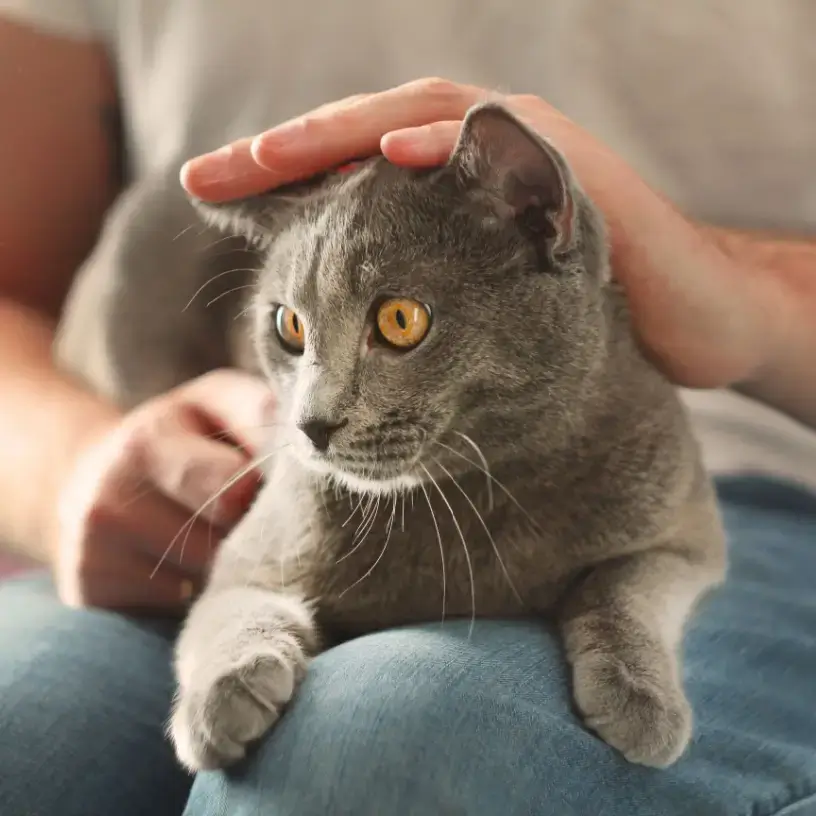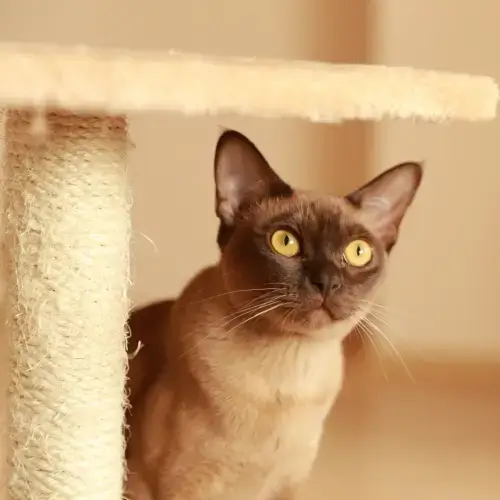Home / Compare Pet Insurance / Hypoallergenic cats
Hypoallergenic cats






Key takeaways
- No cat is truly 100% hypoallergenic, but certain breeds produce less Fel D1, making them a better choice for allergy sufferers. However, individual reactions can vary, so spending time with a breed before adopting is important.
- To help reduce allergens in your home while keeping your cat healthy, you should provide your cat with regular grooming, a clean environment and proper nutrition.
- Pet insurance can help cover the cost of vet visits, treatments and even routine care, depending on the level of cover, ensuring your cat gets the best possible medical attention without unexpected financial strain.
What is a hypoallergenic cat?
Although there is no such thing as a completely hypoallergenic cat breed, there are several that produce less Fel D 1, and people with allergies may handle these breeds better.1
Fel D 1 is a protein found in cat saliva and is the major cat allergen that causes reactions in humans.1 When a cat licks itself to exfoliate dead skin, dander accumulates on the cat’s fur and is transported into the environment when it sheds.
Many allergy sufferers who want to own a cat believe that a hypoallergenic cat breed is a good choice, as it produces fewer allergens than other cat breeds and may be better tolerated by those with allergies.
Hypoallergenic cat breeds
If you’re an allergy sufferer determined to have a feline friend despite allergies, you can consider these furry friends that are known to be hypoallergenic breeds.
Several cat breeds are known to produce lower levels of Fel D1 or are low shedding, making them better suited for allergy sufferers.2 By considering these breeds, allergy sufferers have more options when choosing a hypoallergenic cat that fits their lifestyle. Each breed has its unique personality and care requirements, so it’s essential to find one that matches your home environment.
The best cats for allergy sufferers include:2
Siberian
Siberian cats are the friendly, easy-going type that get along with everyone.3 They love being part of the family, playing with kids and even getting along with other pets. They’re active enough to keep you entertained but also love curling up for a cozy nap. They enjoy a good play session, especially if there’s something fun to chase, but they’re equally content chilling on the couch with you.
Balinese
Balinese cats, although a long-haired breed, are known to produce less dander and are like the social butterflies of the feline world, making them particularly popular among hypoallergenic cat owners.4 They’re incredibly chatty and want to be involved in everything. These cats have a lot of energy, and they can be a bit demanding for attention, but in the best way possible.
Russian Blue
Russian blue cats are recognised for their calm and quiet demeanour.5 They have a strong sense of loyalty to those they care about, despite their lack of extroversion. They will show you love in their own delicate way and are happy to sit quietly and observe the surroundings. If you prefer a low-key, relaxed friend, this is the cat for you.
Devon Rex
Devon Rex cats are eccentric, mischievous souls who bring a lot of joy and laughter into your life. These kitties are extremely energetic and will keep you on your toes.6 They enjoy climbing, jumping and exploring all corners of the house. They love being the centre of attention and will likely follow you around all day to watch what you’re doing.
Cornish Rex
Cornish Rex cats are known for their insatiable desire for attention, lively attitude and eagerness to cuddle.7 They thrive in homes where they receive plenty of attention, making them an excellent choice for active families, those with children or anyone looking for an energetic and social cat.
Oriental Shorthair
Oriental shorthair cats are known for their elegant and sleek appearance, and they only require minimal grooming thanks to their short coats.8 They are known for their activity and curiosity, and they are the perfect combination of intelligence and playfulness.
Burmese
Burmese cats are exceptionally loving and people-oriented, making them an excellent choice for cat owners who enjoy affectionate, clingy cats.9 They are amiable and intelligent felines who enjoy both running around and cuddling on the sofa.
Javanese
Javanese cats are known for their curiosity and friendliness, always seeking to be near you and participate in whatever activity you’re doing.10 They excel with children and other pets and would thrive in a home where they receive plenty of attention. They’re super friendly, and once they decide they like you, they’ll never want to leave your side.
Are hairless cats hypoallergenic?
Hairless breeds, such as Sphynx cats and Bengal cats, are often assumed to be hypoallergenic due to their lack of fur.11 While they don’t shed fur, they still produce a regular level of Fel D1 in their skin and saliva through grooming themselves.
However, regularly bathing and moisturising can help manage the release of dander and thus your allergy symptoms. As they do not shed, the allergens can usually be contained with regular maintenance.
How to choose between hypoallergenic cat breeds
Although all the listed breeds are considered hypoallergenic, individual reactions to specific breeds vary.2 Before adopting a hypoallergenic breed, you should spend time with the cat to see how your allergies react, as getting a cat is an ongoing commitment. Allergic reactions to cat dander can include itchy eyes, sneezing, rashes, hives and difficulty breathing.
Some specialised breeders that breed hypoallergenic cats conduct DNA and saliva testing to see the amount of dander their cat produces.12 If you really want a new furry family member, you can always look for these breeders.
If you’re purchasing or adopting a cat from a breeder or rescue group and you know you have cat allergies, always be upfront about your allergies. You can consider requesting or organising a trial period with the breeder or rescue group before fully committing to being a pet parent.
You can also consult an allergist for professional advice on managing pet allergies and how to build your immune system to be less allergic to cats.
How to take care of a hypoallergenic cat
 While no cat is truly allergen-free, certain breeds and proper care can make cat ownership possible for individuals with allergies. Choosing a hypoallergenic breed with reduced Fel D1 production, practicing excellent cleanliness and minimising environmental allergies can all contribute to a more comfortable living situation.13
While no cat is truly allergen-free, certain breeds and proper care can make cat ownership possible for individuals with allergies. Choosing a hypoallergenic breed with reduced Fel D1 production, practicing excellent cleanliness and minimising environmental allergies can all contribute to a more comfortable living situation.13
- Regular grooming: Wiping your cat’s fur with pet wipes every day and brushing your cat on a regular basis minimises excess cat hair that may transfer into your environment, reducing allergens.
- Maintain a clean environment: Use a HEPA air purifier to trap allergens and vacuum frequently with a high-efficiency filter vacuum to remove allergens from carpets and furniture.
- Set up a contained space: Limit your cat’s access to beds and carpeted areas, which can readily trap fuzz. Set apart specific areas for your cat to sleep and groom to keep the fur and dander
- Diet and nutrition: A high-quality diet, including omega-3 fatty acids, can improve skin health and reduce allergen Specialised cat food can also help a cat create less dander.
- Allergy treatments for cat owners: Allergy sufferers may benefit from antihistamines, allergy shots or specialised immunology treatments.
Why does pet insurance matter for hypoallergenic cats?
If you’re considering adopting a hypoallergenic cat, pet insurance is a worthwhile consideration. While hypoallergenic breeds like the Siberian, Siamese cats or Russian Blue may reduce allergens, they’re not immune to health issues that could end up costing you a lot at the vet.
Pet insurance can help relieve the financial burden, whether it covers accidental injury, illness, or routine veterinary visits. It can often provide peace of mind when your cat falls sick and allows you to focus on taking care of your pet instead of worrying over the financial cost of vet treatments.
Always read the Product Disclosure Statement (PDS) and the Target Market Determination (TMD) to know what is and isn’t covered in your policy and that the policy suits you.
Meet our pet insurance expert, Adrian Taylor
As a General Insurance expert with over 13 years’ experience in financial services, Adrian Taylor knows that dogs and cats get themselves into all sorts of mischief. One part of Adrian’s work is to help empower consumers to understand how pet insurance can help save them from exorbitant vet bills when their pet gets injured or falls ill.
Want to know more about pet insurance?
1 Journal of Allergy and Clinical Immunology (JACI). Fel d 1 and Fel d 4 levels in cat fur, saliva and urine. Accessed April 2025.
2 petMD. 12 ‘Hypoallergenic’ Cats for People With Allergies. Accessed April 2025.
3 petMD. Cat breeds, Siberian. Accessed April 2025.
4 petMD. Cat breeds, Balinese. Accessed April 2025.
5 petMD. Cat breeds, Russian Blue. Accessed April 2025.
6 petMD. Cat breeds, Devon Rex. Accessed April 2025.
7 petMD. Cat breeds, Cornish Rex. Accessed April 2025.
8 petMD. Cat breeds, Oriental Shorthair. Accessed April 2025.
9 petMD. Cat breeds, Burmese Cat. Accessed April 2025.
10 petMD. Cat breeds, Javanese. Accessed April 2025.
11 Affordable Pet Hospital. Cat breeds for people with allergies. Accessed April 2025.
12 Siberiankittens.com.au. Snow gum Siberians, our cats’ Fel d1 levels. Accessed April 2025.
13 TheSprucePets. Tips for minimising cat allergies. Accessed April 2025.